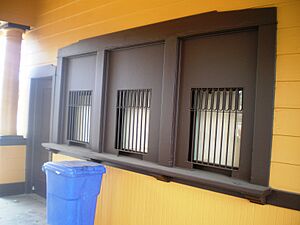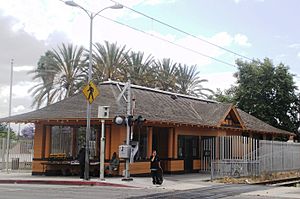Watts Station facts for kids
{{infobox station | name = Watts | style = Pacific Electric | image = Watts Station, Los Angeles.JPG | caption = Watts Station, May 2008 | address= 1686 E. 103rd Street
Watts, Los Angeles, California | opened = 1904 | closed = 1961 | tracks = 4 | services =
| Preceding station | Following station | |||
|---|---|---|---|---|
| Abila
towards Morgan Avenue
|
Long Beach discontinued 1961 |
Latin
towards Pacific Electric Building
|
||
| Abila
towards Balboa
|
Balboa discontinued 1950 |
|||
| Abila
towards San Pedro
|
San Pedro via Dominguez discontinued 1958 |
|||
| San Pedro via Gardena discontinued 1940 |
||||
| Palomar
towards Santa Ana SP Depot
|
Santa Ana discontinued 1958 |
|||
| Centralia
towards Clifton
|
Redondo Beach via Gardena discontinued 1940 |
|||
| Centralia
towards El Segundo
|
Hawthorne–El Segundo | |||
| Terminus | Watts Local discontinued 1958 |
Elcoat
towards Pacific Electric Building
|
||
| nrhp =
}
Watts Station is a historic train station built in 1904 in Watts, California. It was one of the first buildings in the area. For many years, it was a very important stop for the Pacific Electric Railway's "Red Car" service. These electric trains connected Los Angeles and Long Beach.
The station was the only building that stayed standing when many stores on 103rd Street in Watts were burned. This happened during the 1965 Watts Riots, which were a time of great unrest and protests. Because it survived, the station became a symbol of hope and new beginnings for the Watts community. Today, it is recognized as a Los Angeles Historic-Cultural Monument and is listed on the National Register of Historic Places.
Contents
|
Watts Station
|
|
| Built | 1904 |
|---|---|
| Architectural style | Late Victorian |
| NRHP reference No. | 74000523 |
| Added to NRHP | March 15, 1974 |
- What Happened When Red Car Service Ended?
- A Symbol of Hope in "Charcoal Alley"
- Becoming a Historic Landmark and Being Restored
Building the Station and Red Car Service
Watts Station was built in 1904 on land donated by the family of Charles H. Watts. The community of Watts was later named after them. The station was a major hub for the Pacific Electric "Red Car" trains for over 50 years. It was a key stop on the main line between Los Angeles and Long Beach. Other train lines also branched off here, going to San Pedro and Santa Ana.
The station is a single-story building made of wood. It is about 2,200 square feet in size and has three rooms. It was one of the first buildings in Watts. It also served as a design model for other train stations built in places like La Habra and Covina.
When the station opened, it attracted many people to the area. The community that grew around it was even called "Watts Station" at first.
How the Red Cars Helped Watts Grow
The Watts station was a busy place. It connected the Long Beach–Santa Ana line to the San Pedro–Redondo line. This made it easy for people in Watts to travel. Many working-class people relied on the "Red Car" service for their daily trips. This helped the Watts community grow, as people could travel outside their neighborhood for work.
The "Red Car" service also offered fun and entertainment. People in Watts could easily visit other communities. They used the "Red Cars" to go to nightclubs and dance halls in the bigger city areas.
You can see old photos of the station online. A picture from 1906 is available here. Another classic image from the Los Angeles Public Library can be seen here.
The Watts Station was a busy train depot until 1961. That's when passenger train service stopped.
What Happened When Red Car Service Ended?
When the "Red Car" service in Watts ended, it brought big changes to the community. Watts Station lost its main way for people to get around. Many people in Watts had low incomes and could not afford to buy cars. Cars were becoming the main way to travel at that time.
With fewer transportation options, it became harder for people to find jobs. Jobs were spread out across Los Angeles. This meant more travel expenses and fewer work chances for the people living in Watts.
A Symbol of Hope in "Charcoal Alley"
In August 1965, the Watts Riots caused a lot of damage. Buildings all along 103rd Street were destroyed. This street was the main shopping area in Watts. Watts Station was right in the middle of a one-mile stretch of 103rd Street. This area became known as "Charcoal Alley" because of all the destruction.
One person remembered: "Both sides of 103rd Street were on fire. The street was a sea of flames that gave off heat so strong I thought my skin was burning." Another story from the riots said: "On the third day of the Watts Riots, 103rd St. was burned to the ground."
In the middle of all this damage, the Los Angeles Times newspaper reported something amazing. They said "the train station was the only structure that remained intact when stores along 103rd Street burned during the Watts riots." The old wooden Watts Station survived. Whether it was on purpose or just by chance, its survival made it a powerful symbol. The Los Angeles Times called it "a symbol of continuity, hope and renewal" for the Watts community.
Becoming a Historic Landmark and Being Restored
Just four months after the riots, Watts Station was named a Historic-Cultural Monument. This was done by the Los Angeles Cultural Heritage Commission. It was also added to the National Register of Historic Places in 1974.
In the 1980s, the station had been empty for many years. The Community Redevelopment Agency spent $700,000 to fix it up. They restored the building to look like its original design. In 1989, the station reopened. It became a customer service office for the Los Angeles Department of Water and Power. It also had a small museum about Watts history.
Mayor Tom Bradley attended the opening event. He said that the "days of glory are going to return." He believed that the Watts train station would be at the center of new activity.
In 1990, the Metro Blue Line started train service again. It followed the old Pacific Electric tracks from Los Angeles to Long Beach. The old Watts Station building is not used for passengers anymore. However, the new "Watts Station," called 103rd Street-Kenneth Hahn, is right next to it. The Blue Line was renamed the A Line in 2019.






